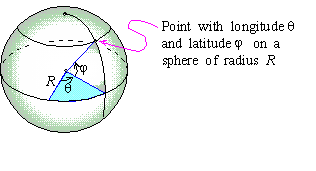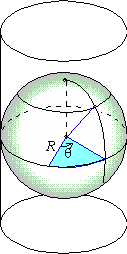Parametric Surfaces
Surfaces can also be defined parametrically. In particular, suppose
each component of a vector-valued function is a function of two variables u
and v:
|
r(u,v) =
á f(u,v) ,g(u,v) ,h(u,v)
ñ |
| (1) |
Then the graph of r( u,v) over some region S in the
uv-plane is a surface in R3, and r( u,v)
is called a parameterization of that surface.
Equivalently, x = f(u,v) , y = g( u,v) , and z = h( u,v) for
(u,v)
in S defines a surface, and the variables u and v are often called the
coordinates of the surface.
Given a parametric surface (1), we often desire to
transform it into a level surface representation of the form U(x,y,z) = k. To do so, we often use the trigonometric identities, such
as the Pythagorean identities
Other identities that may occur include 2sin( t) cos(t) = sin( 2t) and ete-t = 1.
EXAMPLE 1 Find a level surface representation of the surface
parameterized by
|
r( u,v) =
á cos( u) cosh(v) ,sin( u) cosh( v) ,sinh( v)
ñ |
|
Solution: Since x = cos( u) cosh( v) , y = sin( u) cosh( v) , and z = sinh( v), the identity cos2( u) +sin2( u) = 1
leads to
|
|
|
|
cos2( u) cosh2( v) +sin2( u) cosh2( v) |
| |
|
|
cosh2( v) [ cos2( u) +sin2( u) ] |
| |
|
|
|
As a result, the identity cosh2( v) -sinh2(v) = 1 leads to
|
x2+y2-z2 = cosh2( v) -sinh2( v) = 1 |
|
Thus, r( u,v) =
á cos( u) cosh( v) ,sin( u) cosh( v) ,sinh(v)
ñ is a parameterization of the level surface
which we recognize as a hyperboloid in one sheet.
A sphere of radius R centered at the origin is often parameterized in terms of longitude q and latitude j, which results in the parameterization
|
r( q,j) =
á Rcos( j) cos( q) ,Rcos( j) sin(q) ,Rsin( j)
ñ |
| (2) |
where q in [ 0,2p] and j is in [-p/2,p/2] .

EXAMPLE 2 Show that (2) is a
parameterization of the sphere of radius R centered at the origin.
Solution: Since x = Rcos( j) cos( q) , y = Rcos( j) sin( q) and z = Rsin( j) , the identity cos2( q) +sin2( q) = 1 leads to
|
|
|
|
R2cos2( j) cos2( q) +R2cos2( j) sin2( q) |
| |
|
|
R2cos2( j) [ cos2( q) +sin2( q) ] |
| |
|
|
|
Moreover, z2 = R2sin2( j) implies that
|
x2+y2+z2 = R2cos2( j) +R2sin2(j) = R2 |
|
which is the equation of the sphere of radius R centered at the origin.
However, cartographers and mathematicians have long used parameterizations of the sphere other than (2). For example,
in 1599, the mapmaker Gerard Mercator constructed a projection of the
earth's surface in which a straight line on a map corresponds to a fixed
compass bearing on the earth's surface. To do so, he imagined that the
sphere was inside of a cylinder with radius R.

This led to the Mercator parameterization of the sphere:
|
r( q,m) =
á R sech( m) cos( q) ,R sech( m) sin( q) ,Rtanh( m)
ñ |
|
where the hyperbolic secant and tangent functions are defined
|
sech( m) = |
1
cosh( m)
|
, tanh( m) = |
sinh( m)
cosh( m)
|
|
|
We will examine the Mercator parameterization more closely in the exercises.
Check your Reading: How would you define csch(t)?

